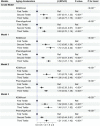Effect of dietary inflammatory potential on the aging acceleration for cardiometabolic disease: A population-based study
- PMID: 36532557
- PMCID: PMC9755741
- DOI: 10.3389/fnut.2022.1048448
Effect of dietary inflammatory potential on the aging acceleration for cardiometabolic disease: A population-based study
Abstract
Background/aim: Optimized dietary patterns have been considered an important determinant of delaying aging in cardiometabolic disease (CMD). Dietary pattern with high-level dietary inflammatory potential is a key risk factor for cardiometabolic disease, and has drawn increasing attention. The aim of this study was to investigate whether dietary pattern with high dietary inflammatory potential was associated with aging acceleration in cardiometabolic disease.
Materials and methods: We analyzed the cross-sectional data from six survey cycles (1999-2000, 2001-2002, 2003-2004, 2005-2006, 2007-2008, and 2009-2010) of the National Health and Nutritional Examination Surveys (NHANES). A total of 16,681 non-institutionalized adults and non-pregnant females with CMD were included in this study. Dietary inflammatory index (DII) was used to assess the dietary inflammatory potential. The two age acceleration biomarkers were calculated by the residuals from regressing chronologic age on Klemera-Doubal method biological age (KDM BioAge) or Phenotypic Age (PhenoAge), termed "KDMAccel" and "PhenoAgeAccel." A multivariable linear regression accounting for multistage survey design and sampling weights was used in different models to investigate the association between DII and aging acceleration. Four sensitivity analyses were used to ensure the robustness of our results. Besides, we also analyzed the anti-aging effects of DASH-type dietary pattern and "Life's Simple 7".
Results: For 16,681 participants with CMD, compared with the first tertile of DII after adjusting for all potential confounders, the patients with second tertile of DII showed a 1.02-years increase in KDMAccel and 0.63-years increase in PhenoAgeAccel (KDMAccel, β = 1.02, 95% CI = 0.64 to 1.41, P < 0.001; PhenoAgeAccel, β = 0.63, 95% CI = 0.44 to 0.82, P < 0.001), while the patients with the third tertile of DII showed a 1.48-years increase in KDMAccel and 1.22-years increase in PhenoAgeAccel (KDMAccel, β = 1.48, 95% CI = 1.02 to 1.94, P < 0.001; PhenoAgeAccel, β = 1.22, 95% CI = 1.01 to 1.43, P < 0.001). In addition, DASH-type dietary pattern was associated with a 0.57-years reduction in KDMAccel (β = -0.57, 95% CI = -1.08 to -0.06, P = 0.031) and a 0.54-years reduction in PhenoAgeAccel (β = -0.54, 95% CI = -0.80 to -0.28, P < 0.001). The each one-unit increase in CVH score was associated with a 1.58-years decrease in KDMAccel (β = -1.58, 95% CI = -1.68 to -1.49, P < 0.001) and a 0.36-years in PhenoAgeAccel (β = -0.36, 95% CI = -0.41 to -0.31, P < 0.001).
Conclusion: Among CMD, the dietary pattern with high dietary inflammatory potential was association with aging acceleration, and the anti-aging potential of DASH-type dietary pattern and "Life's Simple 7" should also be given attention, but these observations require future prospective validation.
Keywords: aging acceleration; biological aging; cardiometabolic disease; dietary inflammatory index; dietary inflammatory potential.
Copyright © 2022 Hu, Wang, Huan, Zhang, Lin, Li and Li.
Conflict of interest statement
The authors declare that the research was conducted in the absence of any commercial or financial relationships that could be construed as a potential conflict of interest.
Figures



Similar articles
-
Better Life's Essential 8 contributes to slowing the biological aging process: a cross-sectional study based on NHANES 2007-2010 data.Front Public Health. 2024 Mar 13;12:1295477. doi: 10.3389/fpubh.2024.1295477. eCollection 2024. Front Public Health. 2024. PMID: 38544722 Free PMC article.
-
Decreased cobalamin sensitivity and biological aging acceleration in the general population.J Nutr Health Aging. 2024 Jul;28(7):100262. doi: 10.1016/j.jnha.2024.100262. Epub 2024 May 20. J Nutr Health Aging. 2024. PMID: 38772151
-
Oxidative Stress Factors Mediate the Association Between Life's Essential 8 and Accelerated Phenotypic Aging: NHANES 2005-2018.J Gerontol A Biol Sci Med Sci. 2024 Jan 1;79(1):glad240. doi: 10.1093/gerona/glad240. J Gerontol A Biol Sci Med Sci. 2024. PMID: 37813096
-
Association of dietary inflammatory potential with cardiometabolic risk factors and diseases: a systematic review and dose-response meta-analysis of observational studies.Diabetol Metab Syndr. 2020 Oct 7;12:86. doi: 10.1186/s13098-020-00592-6. eCollection 2020. Diabetol Metab Syndr. 2020. PMID: 33117453 Free PMC article. Review.
-
Dietary inflammatory potential, cardiometabolic risk and inflammation in children and adolescents: a systematic review.Crit Rev Food Sci Nutr. 2021;61(3):407-416. doi: 10.1080/10408398.2020.1734911. Epub 2020 Mar 10. Crit Rev Food Sci Nutr. 2021. PMID: 32156146
Cited by
-
Relationship between an ageing measure and chronic obstructive pulmonary disease, lung function: a cross-sectional study of NHANES, 2007-2010.BMJ Open. 2023 Nov 2;13(11):e076746. doi: 10.1136/bmjopen-2023-076746. BMJ Open. 2023. PMID: 37918922 Free PMC article.
-
Living in poverty and accelerated biological aging: evidence from population-representative sample of U.S. adults.BMC Public Health. 2024 Feb 13;24(1):458. doi: 10.1186/s12889-024-17960-w. BMC Public Health. 2024. PMID: 38350911 Free PMC article.
-
A combination nutritional supplement reduces DNA methylation age only in older adults with a raised epigenetic age.Geroscience. 2024 Oct;46(5):4333-4347. doi: 10.1007/s11357-024-01138-8. Epub 2024 Mar 26. Geroscience. 2024. PMID: 38528176 Free PMC article.
-
Association between Gut Microbiota and Biological Aging: A Two-Sample Mendelian Randomization Study.Microorganisms. 2024 Feb 11;12(2):370. doi: 10.3390/microorganisms12020370. Microorganisms. 2024. PMID: 38399774 Free PMC article.
-
Association between life's essential 8 and biological ageing among US adults.J Transl Med. 2023 Sep 14;21(1):622. doi: 10.1186/s12967-023-04495-8. J Transl Med. 2023. PMID: 37710295 Free PMC article.
References
LinkOut - more resources
Full Text Sources

